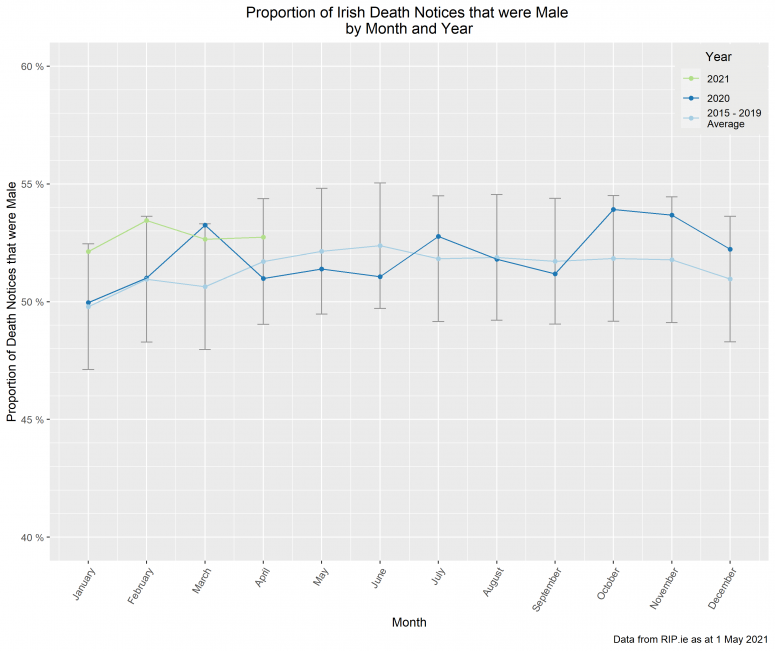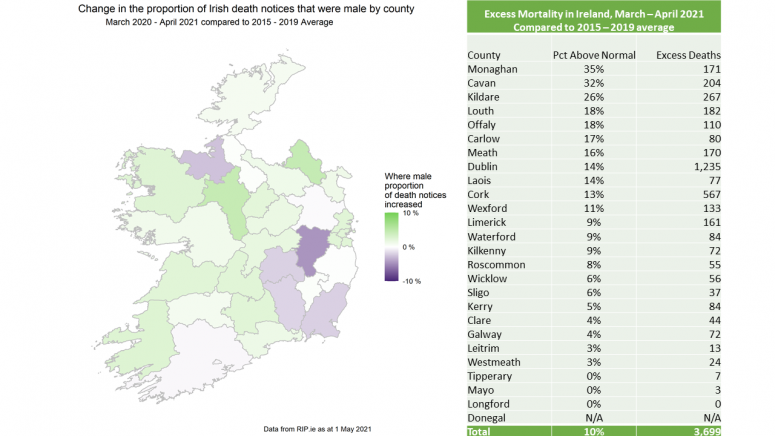The data suggests that we have returned to “normal” levels of deaths in Ireland but we saw the same indicators last summer only to be followed by the second/third wave. It is important that we learn from this experience and remain vigilant so we do not repeat the pattern. The light at the end of the pandemic tunnel is in sight for Ireland and other wealthy countries but the world as a whole is still gripped by the pandemic and, as the WHO, the UN and various international health bodies have repeatedly said, no one is safe until everyone is.
In this post we present the results of our April 2021 analysis of experience in Ireland. Our updated results are based on data from RIP.ie to 1 May 2021 and all data processing and analysis has been undertaken in line with the approach outlined in our earlier blogs.
If experience continues close to “normal” levels, we will move to bi-monthly rather than monthly updates.
Analysis of deaths in Ireland
The chart below shows the number of deaths reported through RIP.ie in each month of 2020 (dark blue) and 2021 (green) against the average number reported for the same month over 2015 – 2019 (light blue). Confidence intervals of two standard deviations are included in the grey bars for perspective.

The number of deaths in April 2021 fell for the fourth consecutive month. While the number of deaths remains above the average, April is the second consecutive month where total deaths might be considered to be at “normal” levels. This a great sign and hopefully indicative of the year ahead. However, caution is still required as the chart above shows, deaths fell to expected levels in the summer of 2020 only to surge again following the easing of lockdown restrictions. This difference this time is, of course, the availability of a vaccine.
Following the success of the recent phase of the vaccination programme, more than 30% of the Irish population[1] (c.40% of the adult population) have received at least one dose of a vaccine. Evidence from around the globe suggests that vaccines reduce the COVID cases, particularly the more severe cases so we have reason to look forward with hope. However, there remains a lot of uncertainty so hope should be coupled with caution. We note below a few incidences/reports which highlight the ongoing uncertainty, this list is not intended to be exhaustive.
- In Northern Ireland, where c.80% of the population has received at least one dose of the vaccine, hotspots of COVID-19 cases remain. In particular, as at 13 May 2021, the district of Derry City and Strabane had one of the highest case-rates in the UK.
- There have been some reports in the media of surges in COVD-19 cases amongst highly vaccinated populations although further research is needed to determine to what extent this is due to reopening of societies rather than differences in the efficiency of the various vaccines.
- New variants continue to challenge the effectiveness of the available vaccines and therefore our ability to return to some level of normality. A number of variants, classified as “variants of concern” by the WHO have reached Ireland and questions remain as to whether the available vaccines provide protection against these. So far, the conclusion has been yes, they do and early indications suggest that this conclusion may hold even for the newest variant (B.1.617 initially identified in India). Nonetheless, as large number of people continue to get infected globally, new variants will undoubtedly emerge and one of these could prove more deadly or less susceptible to the available vaccines.
- International and even domestic travel remains at low levels, one of the greatest areas of uncertainty is how experience will change when non-essential travel resumes.
Analysis by gender
The chart below shows the percentage of death notices that were male in each month of 2020 (dark blue) and 2021 (green) against the corresponding averages from 2015 – 2019 (light blue) and confidence intervals.

The more pronounced male bias in the second-wave deaths has persisted for the seventh consecutive month. The male population is clearly experiencing a higher proportion of deaths over the recent seven months than observed over the first seven months the pandemic (although March 2020 had a higher male proportion on a standalone basis). The data we use for this analysis does not provided any insights into the extent to which this is reflects a bias in the fatality of the virus itself (i.e. males being more likely to die once they have contracted COVID-19) rather than a higher likelihood of infection or an increase in deaths from other causes during the period. This is a topic we will explore more in an upcoming post where we focus specifically on COVID-19 deaths rather than all deaths.
County-level gender analysis
The above analysis was further examined at county level, focusing on both excess mortality and the proportion of male reported deaths from the start of the pandemic through to the end of April 2021. The following map shows the movement in the proportion of reported deaths which were male, with the excess mortality for each county in the corresponding table.

As discussed in previous posts, the experience observed in Donegal appears to be caused by a change in the way RIP.ie is used in the county rather than real experience and therefore, we have excluded it from the table. Similar features have not been observed in the other counties so the above breakdown remains our best view of the county level impact at the current time.
[1] https://ourworldindata.org/covid-vaccinations AND/OR https://covid-19.geohive.ie/pages/vaccinations
COVID-19 Action Group
The views of this article do not necessarily reflect the views of the Society of Actuaries in Ireland.